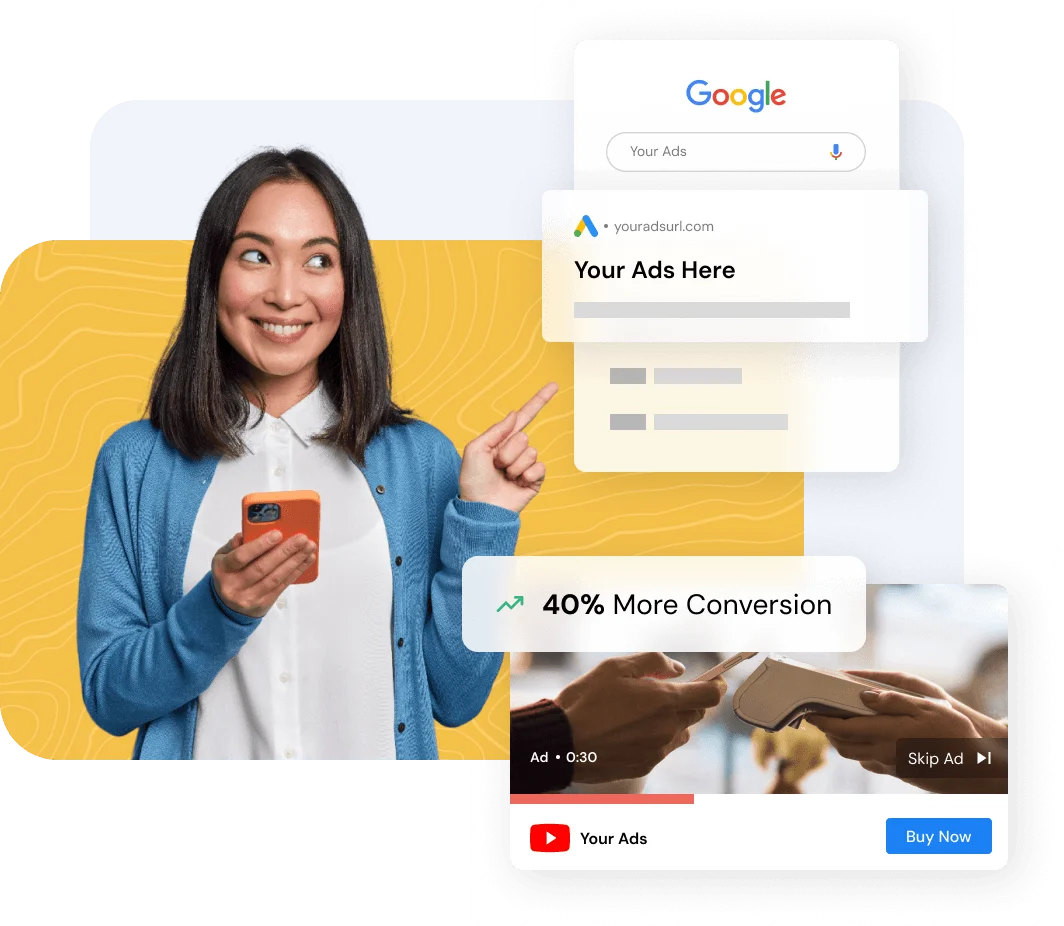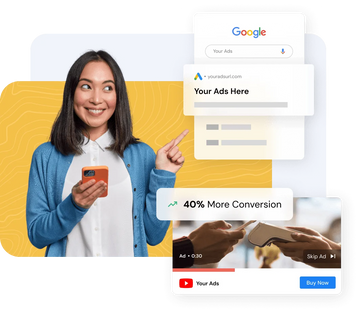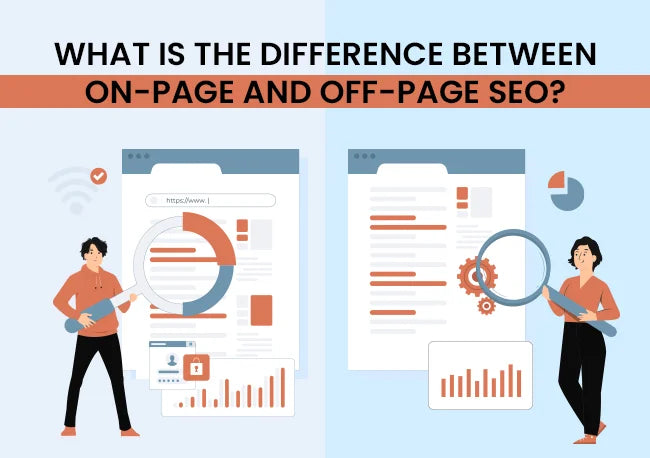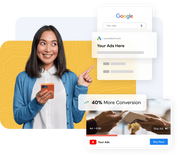Google Ads Service
Google Ads Service
Couldn't load pickup availability
✅ 5 Days Management & Optimization: £99
✅ 14 Days Management & Optimization: £199
🔛 Full Setup of Google Ads Campaigns + 14 Days Management and Optimization + Weekly Update
✅ 30 Days Management & Optimization: £399
🔛 Full Setup of Google Ads Campaigns + 30 Days Management and Optimization + Weekly Update
PPC Management Services for High ROAS
Hire ROI Minds Pay-per-click agency to make your PPC campaigns profitable from the very first week.
Google Ads can change your business if done right. ROI Minds is not just an inbound SEO & Google ads marketing agency, it leads businesses to profits. We have designed our best PPC Management services for small, medium, and large businesses to enhance their profits, revenues, and business.
We've generated over
$2,214,145,292in revenue for our clients
We've generated over
1,000,000 leads for B2B and B2C brands
A team of
40+google ads experts

PPC Services
Our campaign’s craft is based on the users’ customer journey and buying intent. Our ongoing PPC advertising services include but are not limited to the following:

Google Shopping Ads
One of the best advertising methods for e-commerce stores. If you’re not able to harness the power of Google shopping ads, you simply leave more than 50% of your profits on the table. Our PPC services company generated a remarkable 3000% ROI for our clients through Google Shopping Ads.

Google Search Ads
95% of people run Google search ads in the wrong way. They don’t target them to specific users with specific offers. The best feature of Google Search ads is clear user intention. Our Google ads agency utilizes intent-based ad targeting to deliver high-quality conversions, ensuring that ads are tailored to specific users and their needs.
Performance Max Ads
Performance Max's ability to run advertisements across the whole Google Network from a single campaign is one of its key selling advantages. Search, shopping, Gmail, YouTube, maps, discovery, and display are all included, and our PPC management services team is an expert.

Local PPC Ads
If your business depends on footfall, Google local ads are the solution. Showing ads immediately brings more foot traffic directly from Google Maps to your store. Whether it's the call only ads or direction ads, users will find you on the maps with our best PPC advertising services.

Google Remarketing Ads
Follow your website visitors everywhere through Google Remarketing Ads. Show the exact product or page they have visited on the website with a better offer and message. Drive 2X more revenue with our best Google remarketing campaigns that use our best PPC marketing services. Let us know if you need help!

Google Display Ads
Google has the largest inventory of websites and apps to show display ads. Optimization of profitable traffic is a skill and art, and we do it on the day to day basis. Target the best audience with the available features like household income, interests, affinity, etc.

Frequently Asked Question
What is Google Ads?
What is Google Ads?
Google’s internet advertising network is known as Google Ads, formerly known as Google AdWords. The Google Display network enables companies to post advertisements on Google search results in pages and numerous other pages.
What's your approach toward Google Ads?
What's your approach toward Google Ads?
We adopt a data-driven and results-focused approach to Google Ads, which enables us to deliver outstanding results for our clients. Because each client is unique, we are a specialized Google ads marketing agency emphasizing generating game-changing outcomes for our client’s businesses.
We take the time to fully understand each client’s business in order to fully comprehend their offering and goals. We will give you actionable recommendations to crush your goals, whether they be maximizing sales or increasing lead volumes, by comprehending your business model and the competitive landscape.
What are your core capabilities?
What are your core capabilities?
We are a full-scale digital marketing agency, and we help a business market their products/services online profitably. We use the latest strategies and techniques of PPC, SEO, Facebook Ads, Social Media, Content Marketing, and Landing Pages.
How often should we update my Google Ads?
How often should we update my Google Ads?
At ROI Minds, we continuously monitor and test as often as the data permits. The goal and the data we have will determine how often we update the advertising. We will test out new ad text and various angles as we locate opportunities in ad relevancy and anticipated CTR. The frequency of ad rotations will depend on our budget and conversion volume as we prioritize data-driven decisions. We will talk about this on our weekly sync calls because every week will be different. Overall, we succeeded.
How many Ads should I run?
How many Ads should I run?
Our budget and conversion volume will determine this. We begin by covering both Search categories with responsive search and extended text advertisements. From there, we will optimize rolling out fresh material and starting tests after establishing a baseline CTR and quality score.
What does a Google Ads agency do?
What does a Google Ads agency do?
Businesses can market their brands, goods, or services with Google Ads with the aid of Google Ads firms. They may design advertisements and landing sites, manage campaigns, test and improve their ads, and monitor the effectiveness of their efforts. They could be compatible with Google Shopping ads, remarketing ads, display network ads, Google search ads, and more. Some Google Ads companies are authorized Google Partner companies.
What type of clients do you have worked with?
What type of clients do you have worked with?
We have assisted companies in a variety of industries, including lead generation for B2B and B2C businesses, real estate, e-commerce, fashion, education, roofing, automobiles, and finance. We have collaborated with a wide range of businesses, including small and large ones like BMW and Isuzu.
How much should I spend on Google Ads?
How much should I spend on Google Ads?
How much should we spend on Google Ads management? is one of the most often requested questions by potential clients.
The reality is that the response to this question varies depending on a wide range of variables, including market competitiveness, the size of the company, the number of leads needed each month, the desired amount of sales, and so forth.
When you contact our Google Ads agency, we can assist you in defining your monthly media budgets depending on your company’s goals and expansion strategies.
What’s a good start budget?
What’s a good start budget?
We advise starting with a $3,000–$5,000/month test budget if you aren’t already spending or if your monthly spending is less than $5,000. We’ll be able to develop our campaign structure at that spending level without having to stretch our resources too thin. Within the first 6-8 weeks, we’ll also be able to gather enough conversion events to perform data-driven optimizations and create a baseline (depending on your product or service). If your monthly expenditure exceeds $5,000, we’ll start there and focus on streamlining your account structure. After that, we’ll concentrate on scaling to ensure that performance and traffic are unaffected.
Why work with a Google Advertising Agency?
Why work with a Google Advertising Agency?
A qualified Google advertising agency can help you get the most out of your advertising budget, save you time, and boost the effectiveness of your campaigns. While you concentrate on other areas of your business, they have the knowledge and resources to use Google Ads to get substantial results.
OUR CLIENT RATE US
bogdangringo
I highly recommend Ecom Explore ! He played a key role in boosting our agency’s CPR from 2% to 27% in just a few days. He also optimized our campaign by carefully selecting the best-performing keywords and explaining everything clearly to ensure I fully understood the process. A true expert in his field—highly recommended!
danieldarrow
Ecom Explore is extremely skilled and goes into depths I couldn't even imagine on google. I am planning now for at least another month to work with Andrii and can see sales growing at an exponential rate. Thank you Andrii for all you do and making this experience enjoyable.:)
totalsir
Great to work with! Optimized my google ads and immediately started seeing results. Went above & beyond to strategize how to get the most out of our google ad campaign. Would definitely work with again!!!
georgianpreda
Ecom Explore is amazing! HIGHLY RECOMMEND!Had some major problems with my adds account, unknown issues, Andrii was able to put it together in a very short time and get it back on track! Unbelievable results after his work!once again HIGHLY RECOMMEND
Latest Trends & Strategies
How to Start a Shopify Store in 2025 | The Best Guide
Did you know that over 4 million active websites are currently powered by Shopify? I remember feeling overwhelmed when I first started my e-commerce journey, but here’s the truth: Launching your own Shopify store is easier than you might think. Whether you’re looking to turn your passion into profit or start a side hustle that could become your full-time gig, this comprehensive guide will walk you through everything you need to know. No technical expertise is required, I promise. Let’s transform your business idea into a reality. Disclosure: This post contains affiliate links, so if you make a purchase, I’ll earn a commission at no extra cost to you. What is Shopify? Shopify is one of the world’s leading e-commerce platforms, trusted by millions of businesses to power their online stores. Founded in 2006, Shopify has grown into a robust platform offering a wide range of tools to help entrepreneurs build, manage, and scale their online businesses. Whether you’re a small business owner, a large retailer, or a side hustler, Shopify provides an intuitive, user-friendly interface that simplifies the entire e-commerce process. With Shopify, you can easily create a fully customizable online store without any coding knowledge. It offers various templates, payment integrations, and inventory management tools to streamline your operations. Additionally, Shopify supports multiple sales channels, allowing you to sell on social media, marketplaces, and even in-person with Shopify POS. Its scalability makes it ideal for beginners and experienced merchants alike. Whether you’re selling a single product or managing a large inventory, Shopify provides the flexibility, security, and support needed to succeed in the competitive world of e-commerce. Choosing What to Sell on Shopify Shopify Shopify is an e-commerce website builder with many features for launching and managing an e-commerce business. Over 6.4 million sites are powered by Shopify. Try Shopify free Leading e-commerce website builder 1. Identify Your Passion and Expertise: Start by thinking about products you’re passionate about or knowledgeable about. When you sell something you love, it’s easier to stay motivated and connect with your audience authentically. 2. Research Market Demand: First, analyze current market trends and consumer needs. You can use tools like Google Trends, Amazon Best Sellers, and social media platforms to help you identify popular and emerging products. I look for the items that solve a problem or add value to people’s lives. 3. Find a Niche: Narrowing down the broader topics and picking up a specific topic can help you stand out from the competition. Instead of selling generic items, consider targeting a specific audience, e.g., home decor, mental health, crypto, and the list goes on. 4. Evaluate Profit Margins: Calculate the cost of goods, and finalize your sourcing and shipping plateform, and Shopify fees to determine if the product is profitable. Aim for items with a healthy profit margin that allows you to cover expenses and invest in the growth of your business. 5. Test Your Ideas: This is an important method. Before committing to inventory, test your product ideas with dropshipping or pre-orders. This approach minimizes risk and gives you valuable feedback on customer demand. Now, the key to finding the best product to sell is to find what people are interested in and what is profitable. By doing your homework, you’ll set yourself up for success on Shopify. Guide to Starting Your Shopify Store Starting a Shopify store is simple, and I’ll walk you through the exact steps. By the end of this guide, you’ll have your store ready to launch. Let’s dive in! Step 1: Try Shopify for free First, go to Shopify’s website and sign up for a free trial. You’ll need to create an account by entering your email, password, and store name. Don’t worry about the store name—it can be changed later if needed. Once you’re signed in, Shopify will guide you through a quick setup process. Follow the prompts, and you’ll be taken to your Shopify dashboard, where all the magic happensStep 2: Add Your First Product Click on “Products” in the Shopify dashboard and then select “Add Product.” Enter your product name, description, and price, and upload high-quality images. Make sure your description is clear and tells people why they should buy your product. For example, highlight the benefits, features, and any special details. Don’t forget to set inventory details like stock quantity and SKU if needed. Once done, click “Save.” Step 3: Pick Your Domain Name A domain name is your store’s web address. You can buy a domain directly from Shopify or use a third-party service like Namecheap. Keep your domain simple, short, and easy to remember. For example, if you’re selling handmade candles, a domain like digitalagenda.me works great. Once you’ve picked one, connect it to your Shopify store in the “Domains” section of the settings. Step 4: Customize Your Online Store Shopify offers free and paid themes to customize your store’s look. Go to “Online Store” in your dashboard, choose “Themes,” and browse the options. After selecting a theme, you can start customizing. Add your logo, change the colors, and adjust the layout to match your brand. Use the drag-and-drop editor to add sections like a banner, featured products, or testimonials. I recommend keeping the design clean and user-friendly to make shopping easier for your customers. Step 5: Set Up Shipping and Delivery In the “Settings” section, go to “Shipping and Delivery.” Here, you’ll set up shipping zones and rates. Decide how you’ll ship your products. You can offer free shipping, flat-rate shipping, or real-time calculated rates based on the carrier. If you sell digital products, disable shipping for those items. Make sure to test your shipping setup by simulating a purchase to ensure everything works smoothly. Step 6: Set Up Payments Go to “Settings” and click on “Payments.” Shopify Payments is the easiest way to accept payments, but you can also connect PayPal or other options like Stripe. Make sure to choose payment methods that your customers will find convenient. Shopify will guide you through setting up bank account details to receive payouts. Step 7: Optimize Your Store for Launch Before you launch, take time to optimize your store. Check the following: Add an About Us page to tell your story. Set up Contact Us details so customers can reach you. Test the checkout process to make sure everything runs smoothly. Install apps like email marketing tools or analytics for extra features. When you’re ready, remove the password protection on your store under “Preferences” and hit “Publish!” How to Grow Your Shopify Store Once your Shopify store is live, the next step is growing your sales and customer base. Here are some simple strategies you can start with: 1. Use Social Media to Promote Your Store Platforms like Instagram, Facebook, and Pinterest are great for showcasing your products. Post regularly, share behind-the-scenes content, and use hashtags to reach more people. If your budget allows, run targeted ads to drive traffic. 2. Start an Email List Collect emails from visitors by offering a discount or freebie in exchange for their email addresses. You can use Shopify apps like Klaviyo to send regular emails about sales, new products, or special events. 3. Optimize for SEO SEO (Search Engine Optimization) helps people find your store through Google. Use clear product titles, write detailed descriptions, and add keywords your customers might search for. You can also start a blog to share tips or stories related to your products. 4. Offer Discounts and Free Shipping Run promotions to encourage people to buy. Free shipping or a limited-time discount can make a big difference in converting visitors into customers. 5. Leverage Customer Reviews Ask your happy customers to leave reviews. Positive reviews build trust and encourage others to shop from your store. Build Your Own Website – No Coding Needed! Want to create a professional website? Follow our step-by-step guide and launch your site in minutes.FAQs About Starting a Shopify Store 1. Do I need technical skills to use Shopify? No, Shopify is designed for beginners. You can build and run your store without coding or technical knowledge. 2. How much does Shopify cost? Shopify’s basic plan starts at $39/month. They also offer a free trial, so you can test it before committing. 3. Can I sell physical and digital products on Shopify? Yes, Shopify lets you sell both physical and digital items. You can even sell services or subscriptions. 4. What payment methods can I use? Shopify supports various payment gateways like Shopify Payments, PayPal, and Stripe, allowing you to accept credit cards, debit cards, and more. 5. How do I get traffic to my store? Start with social media marketing, email campaigns, and SEO. Paid ads can also help if you’re ready to invest. Conclusion – How to Start a Shopify Store Starting a Shopify store might seem overwhelming at first, but it’s completely manageable when you take it step by step. Remember, every successful store owner started as a beginner, just like you. Focus on creating a great shopping experience, promoting your store, and learning as you go. Whether you’re building a side hustle or aiming for a full-time business, Shopify gives you all the tools you need to succeed. Take your time, stay consistent, and don’t be afraid to try new strategies. Your journey to building a successful Shopify store starts today—let’s make it happen!
Learn moreHow to Use Influencer Marketing to Enhance Your Off-Page SEO
Off-page SEO is an essential component of any successful digital marketing strategy. It involves activities outside your website, such as building backlinks, improving brand mentions, and increasing social signals, to boost your search engine rankings. One powerful strategy to achieve these goals is influencer marketing. This article explores how influencer marketing can be leveraged to enhance your off-page SEO, offering practical steps and insights. Understanding Off-Page SEO Off-page SEO refers to all the actions taken outside your website to impact your rankings on search engine results pages (SERPs). The key elements include: Backlinks: Links from other websites pointing to your own, signaling trust and authority to search engines. Social Signals: Engagements like shares, likes, and comments on social media platforms. Brand Mentions: References to your brand name across the web, even without direct links. While off-page SEO is vital, building a strong profile often requires strategic outreach—and that’s where influencer marketing comes in. The Role of Influencer Marketing in SEO Influencer marketing involves partnering with individuals who have a substantial following and influence within a specific niche. These influencers can amplify your brand’s reach, credibility, and engagement. Here’s how influencer marketing directly supports off-page SEO: Quality Backlinks: Influencers often have high-authority blogs or websites. Collaborating with them can result in backlinks that enhance your site’s domain authority. Increased Social Engagement: Influencers’ social media posts can drive traffic to your site, creating valuable social signals. Brand Mentions: Influencers’ endorsements can boost your brand’s visibility and trustworthiness across the web. By integrating influencer marketing into your SEO strategy, you can tackle the challenges of off-page SEO more effectively. Steps to Leverage Influencer Marketing for Off-Page SEO Define Clear Objectives Start by establishing your off-page SEO goals. Do you want more high-quality backlinks? Are you looking to drive referral traffic? Perhaps you aim to boost your brand mentions? Defining these goals will help you design a focused influencer marketing campaign. Identify the Right Influencers Finding the right influencers is crucial. Look for those who align with your niche and have an engaged audience. Evaluate influencers based on: Domain Authority: Ensure their website has a strong domain authority. Engagement Metrics: High engagement rates on social platforms indicate an active, interested audience. Audience Relevance: Their followers should match your target demographic. Create Authentic Content Collaborations To maximize the benefits of influencer marketing for SEO, focus on authentic and value-driven content. Some effective collaborations include: Sponsored Blog Posts: Ask influencers to write about your brand and include backlinks. Guest Blogging: Contribute articles to their blogs, ensuring links point back to your website. Co-Branded Content: Develop content that benefits both your brand and the influencer’s audience. Utilize Social Media for Amplification Influencers’ social media platforms are ideal for creating buzz around your brand. Encourage them to share your content with their followers. Use unique hashtags or creative campaigns to amplify the impact. Monitor and Optimize Campaigns Track the success of your influencer marketing campaigns using tools like Google Analytics, Ahrefs, or SEMrush. Monitor metrics such as backlinks, referral traffic, and social shares. Use this data to refine your strategy and maximize results. Benefits of Using Influencer Marketing for Off-Page SEO Here are some key benefits of combining influencer marketing with your off-page SEO strategy: Improved Domain Authority: High-quality backlinks from influencers’ websites can boost your site’s authority. Higher Search Rankings: Increased referral traffic and social signals positively influence search engine rankings. Enhanced Brand Trust: Associating with credible influencers builds trust and credibility for your brand. Wider Reach: Influencers help you reach new audiences, driving more organic traffic. Common Pitfalls to Avoid While influencer marketing is highly effective, there are some pitfalls to watch out for: Partnering with Irrelevant Influencers: Ensure the influencers align with your brand and audience. Prioritizing Quantity Over Quality: Focus on securing a few high-quality backlinks rather than many low-value ones. Lack of Transparency: Always disclose sponsored content to maintain trust with your audience. Case Studies and Success Stories Many brands have successfully leveraged influencer marketing to enhance off-page SEO. For example: A fashion brand partnered with niche bloggers to create backlinks and saw a 40% increase in organic traffic. A tech company collaborated with industry influencers for guest blogs, improving their domain authority by 15 points. These examples illustrate the tangible benefits of integrating influencer marketing into your off-page SEO strategy. Tools and Resources To streamline your influencer marketing efforts, consider using: BuzzSumo: For finding influencers and analyzing their content. NinjaOutreach: For managing influencer outreach campaigns. Ahrefs or SEMrush: For tracking backlinks and SEO performance. Conclusion Influencer marketing is a powerful tool for enhancing your off-page SEO. By partnering with the right influencers, creating authentic collaborations, and monitoring your campaigns, you can build a stronger online presence, improve search engine rankings, and boost brand credibility. Start small, experiment, and refine your strategy over time to achieve the best results. Embrace influencer marketing today and watch your off-page SEO efforts soar.
Learn moreHow to Find Your Niche as a Content writing
In the dynamic world of content writing, carving out a niche can be a game-changer. Specializing in a particular area allows you to stand out, build credibility, and command better rates. While being a generalist has its advantages, focusing on a niche gives you the expertise and depth that many clients value. This article will guide you through the steps to discover your niche in content writing and set yourself apart in the competitive market. Understanding the Concept of a Niche A niche in content writing refers to a specific area of expertise or focus. Instead of writing about everything, niche writers concentrate on particular topics or industries, such as technology, health and wellness, or finance. By doing so, they cater to targeted audiences and develop a unique voice that resonates with their readers. For instance, technical writers may create software manuals, while lifestyle writers focus on travel or fashion blogs. The distinction between generalists and specialists is simple: generalists cover a broad range of topics, while specialists hone in on one or two areas. Understanding this difference is crucial for determining your path in content writing. Assessing Your Skills and Interests Finding your niche starts with self-assessment. Ask yourself the following questions: What are you passionate about? Topics you genuinely enjoy writing about are more sustainable in the long run. What are you good at? Do you excel at storytelling, breaking down complex concepts, or persuasive writing? What knowledge do you already have? Leverage your expertise in areas where you already have a strong foundation. For example, if you have a knack for simplifying technical concepts, you might excel in writing user guides or software reviews. Aligning your interests with your skills ensures that you remain motivated and productive in your content writing journey. Researching Market Demand Even if you’re passionate about a topic, it’s essential to ensure there’s demand for it in the content writing market. Research can help you identify niches with high potential. Here’s how: Use Tools to Analyze Trends: Platforms like Google Trends and keyword research tools reveal what topics are gaining traction. Explore Job Boards: Websites such as Upwork or LinkedIn job boards provide insights into what clients are actively seeking. Check Competitors: Look at other writers in your desired niche to assess competition and opportunities. For instance, niches like digital marketing or sustainable living are currently in high demand due to their relevance in today’s market. Identifying such opportunities can give you an edge in content writing. Leveraging Your Professional Background Your past experiences can serve as a strong foundation for niche specialization. If you’ve worked in healthcare, transitioning into medical content writing might be a natural fit. Similarly, a background in finance can pave the way for opportunities to write investment guides or personal finance blogs. Think about the industries you’ve been part of and consider how they align with your interests. Drawing on your professional background not only makes niche selection easier but also enhances your credibility as a writer. Experimenting with Different Topics Before committing to a niche, it’s wise to test the waters. Experimenting with various topics allows you to gauge your interest and assess client responses. Here are some tips: Freelance Platforms: Use platforms like Fiverr or Upwork to take on projects in different areas. Personal Blog: Start a blog to explore topics you’re curious about and track engagement. Feedback Analysis: Pay attention to the feedback you receive from clients and readers. This exploratory phase is a valuable step in refining your niche. For example, if you enjoy and receive positive feedback for your articles on fitness, it could be a sign that health and wellness content writing is your ideal niche. Developing Expertise in Your Chosen Niche Once you’ve identified a niche, it’s time to deepen your knowledge and skills. Expertise is a key factor that sets successful niche writers apart. Here’s how to build it: Take Online Courses: Platforms like Coursera or Udemy offer niche-specific courses. Read Industry-Specific Books: Stay informed by reading books and publications related to your niche. Attend Webinars and Events: Networking with professionals and attending industry events can provide valuable insights. For example, if you choose SEO-focused content writing, taking courses on search engine optimization and staying updated on algorithm changes will keep you competitive. Building a Portfolio Tailored to Your Niche A well-crafted portfolio is crucial for showcasing your expertise in content writing. When building your portfolio, ensure it aligns with your chosen niche. Here’s how: Include Relevant Samples: Showcase your best work that directly relates to your niche. Highlight Metrics: Include case studies or analytics that demonstrate the impact of your writing. Use Professional Platforms: Create a personal website or use LinkedIn to display your portfolio. For instance, if your niche is travel writing, include blog posts, guides, or reviews that highlight your storytelling skills and knowledge of destinations. Marketing Yourself Effectively Positioning yourself as an expert in your niche requires strategic marketing. Here are some steps to take: Create a Personal Brand: Develop a consistent voice and professional image that reflects your niche. Leverage Social Media: Share insights, tips, and articles related to your niche on platforms like Twitter or LinkedIn. Guest Blogging: Write for established blogs in your niche to gain exposure. Network: Attend industry events, join forums, and connect with professionals in your field. Effective marketing not only attracts clients but also establishes your authority in content writing within your niche. Staying Flexible and Open to Evolution The world of content writing is ever-changing, and staying adaptable is vital. Your niche might evolve as industry trends shift or as your interests change. For example, a writer specializing in print media may transition to digital marketing due to market demand. Be open to exploring new opportunities and refining your niche over time. Continuous learning and flexibility ensure you remain relevant and successful in the long run. Conclusion Finding your niche in content writing is a journey that involves self-assessment, research, and continuous learning. By understanding your strengths, aligning them with market demands, and building expertise, you can establish yourself as a sought-after writer in your chosen field. Remember, choosing a niche doesn’t mean limiting your opportunities—it means focusing your efforts to maximize your impact. Embrace the process, stay curious, and watch your content writing career flourish.
Learn more






